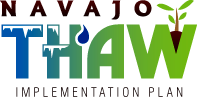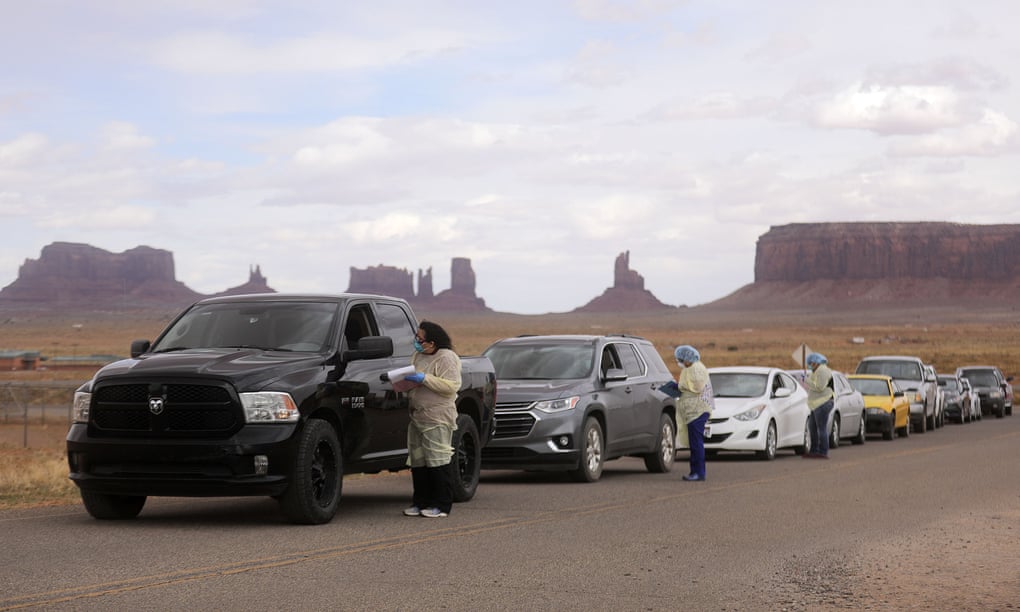Native Americans being left out of US coronavirus data and labelled as ‘other’
The Guardian
By Rebecca Nagle | April 24, 2020
Misclassification raises fears of hidden health emergencies in one of the country’s most vulnerable populations
Native Americans are being left out of demographic data on the impact of the coronavirus across the US, raising fears of hidden health emergencies in one of the country’s most vulnerable populations.
A Guardian analysis found that about 80% of state health departments have released some racial demographic data, which has already revealed stark disparities in the impact of Covid-19 in black and Latinx communities. But of those states, almost half did not explicitly include Native Americans in their breakdowns and instead categorized them under the label “other”.
“By including us in the other category it effectively eliminates us in the data,” Abigail Echo-Hawk (Pawnee), director, urban Indian health board and chief research officer, Seattle Indian Health Board, told the Guardian.
In states that do categorize Native Americans in the demographic results, early data indicates dramatically disproportionate rates of infection and death. Last week, the Arizona department of health services reported that Native Americans make up 16% of the state’s Covid-19 related deaths, despite representing only 6% of the state’s population. In New Mexico, Native Americans make up less than 10% of the population but over one-third of coronavirus cases.
This week, the health authority for the Navajo Nation, which includes areas of Arizona, Utah and New Mexico, reported 1,197 positive coronavirus cases and 44 deaths. If it were a state, it would rank third in the country for confirmed cases per 100,000 population, behind only New York and New Jersey (though the nation is also testing at a far higher rate than most states).
Communities of color are not more susceptible to coronavirus, but because of years of unequal access to healthcare, clean water and nutritious food, they are at greater risk of developing complications. According to the Centers for Disease Control and Prevention (CDC), Native Americans experience diabetes three times more than any other racial or ethnic group in the United States, and have the highest rates of asthma. Before the pandemic, the federal health system serving Native Americans was already chronically underfunded.
The Guardian found health departments did not include Native Americans in their racial demographic data even in areas with high numbers of Native residents. The majority of Native Americans live in urban areas, with the highest populations in New York City and Los Angeles. But neither explicitly include Native Americans in the breakdowns of their Covid-19 data.
The NYC department of health and mental hygiene did not respond to the Guardian’s request for comment. The Los Angeles county department of public health said it was “looking into getting more accurate information on the race/ethnicity field” and hoped to provide “more meaningful reports on this in the future”.
Half of all American Indian and Alaskan Natives live in just 10 states, according to the US Census Bureau. As of 21 April, all 10 had published some racial demographic data, but four – Texas, Florida, New York and Michigan – had not included a breakdown for Native Americans. A spokesperson for the Texas department of state health services said that Native Americans were categorized as “other” because their case numbers were small compared with other groups.
“We are a small population of people because of genocide. No other reason,” said Echo-Hawk. “If you eliminate us in the data, we don’t exist. We don’t exist for the allocation of resources.”
Leaving Native Americans out of public health data is not new in the US. For example in January, the CDC released its most comprehensive study to date on race and maternal mortality rates, but American Indians and Alaskan Natives were not included. When the Urban Indian Health Institute did its own research, it found Native women living in cities were 4.5 times more likely to die during pregnancy and childbirth than white women.
Health experts have also warned that local and state health departments that are including Native Americans in their demographic data are still likely to be undercounting Native Covid-19 patients and deaths due to racial misclassification.
According to some studies, Native Americans have a 50% chance of being listed as the wrong race on medical records, as well as birth and death certificates. A 2015 study of hospital discharge records in Oregon found that over half of Native patients had been miscategorized on their file, the majority as white. A separate 2014 study found that 30% of Native American patients had been miscategorized on their death certificates.
The Indian Health Services (IHS), a chronically underfunded federal healthcare system that serves 2.5 million tribal citizens in 37 states, has been publishing testing results daily during the coronavirus outbreak.
While not every Native person accesses healthcare through IHS, the system ought to be best placed to provide a snapshot of the impact of the Covid-19 in Indian country. But IHS cannot track hospitalization or mortality data for most of its patients, because the majority of IHS facilities do not provide intensive care, and so critically ill patients are transferred to non-IHS hospitals.
The “IHS may not be notified of deaths” wrote an agency spokesperson. Therefore “to avoid underreporting”, IHS is only publishing testing results, they said.
But testing numbers are also incomplete. The IHS includes a network of facilities operated by the IHS, tribal health services, and urban providers. Only IHS direct service facilities are required to report their data , representing about 17% of the facilities in the system. For all others, data sharing is voluntary. According to an IHS spokesperson, about a third of tribally run and urban facilities have reported their numbers.
IHS is also hampered by an electronic record system that was developed in the 1980s. An IHS spokesperson said “a replacement is necessary” but in the meantime, “Covid-19 surveillance data is being collected manually”.
“Health disparities are nice words for systematic racism … it’s the residual effects of the founding of this country,” social demographer Desi Rodriguez-Lonebear (Cheyenne) told the Guardian.
But Rodriguez-Lonebear said it was not enough to just include Native Americans in demographic data; the data also needs to include tribal affiliation. For tribal governments, she said, “being able to identify who your citizens are in these big data sets is so vital to being able to understand the impact of the virus on your tribe”.
Unlike states and counties, tribes cannot rely on healthcare systems to tell them when their citizens are sick or dying and must collect the data themselves. The Guardian asked 15 state and local health departments with high Native populations if they were collecting tribal affiliation. None reported doing so.
“We wish we had the resources to drill down to the tribal affiliation; however, we are not able to at this point,” a spokesperson for Maricopa county, which includes the city of Phoenix, said.
The only public national coronavirus database reporting tribal affiliation is being run by the independent Native newspaper, Indian Country Today, whose team of 16 people has been adding the positive Covid-19 cases and deaths they can verify to a daily report on their website.
“Often researchers and legislators say there is no data” on health issues affecting Indian country, said Jourdan Bennett-Begay (Navajo), ICT’s Washington editor. But he did not want that to happen after this pandemic. “We don’t want to be forgotten”.
ICT’s database is already being used by a team of indigenous researchers at UCLA and the University of Arizona, that includes Rodriguez-Lonebear, to look at characteristics – such as a lack of access to running water, that might be facilitating the spread of Covid-19 in Indian country and what interventions could potentially slow down a second wave. In Navajo Nation, for instance, one in three people do not have access to running water or electricity.
Senator Elizabeth Warren and congresswoman Ayanna Pressley, both Democrats, joined others to introduce a bill last week calling for consultation with tribal governments on federal data collection and an additional $3m for Indian Health Services.
“You can’t fix what you can’t see,” Warren said last week. “If we want to slow the spread of the virus and ensure our response is robust and equitable, we need comprehensive data on who is getting tested, who is getting treatment, and who is dying.”
The bill did not address racial misclassification or data collection on tribal affiliation.
However, Echo-Hawk thinks it is already too late to be accurately represented in the data about the current outbreak.
“With what we’re seeing right now, there will absolutely be a gross undercount of the effects of Covid on American Indian and Alaska Native peoples,” she said. “We have an opportunity to prepare for the next wave.”

